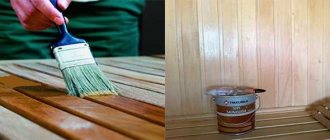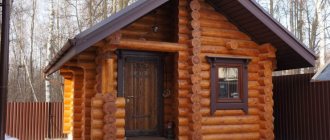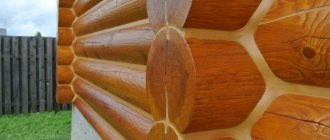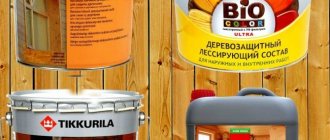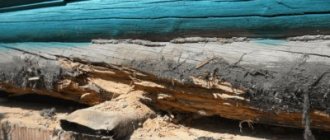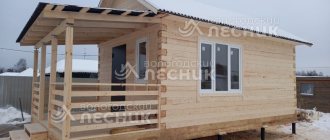How to cover the inside of a log house, and is it necessary to do it at all? Manufacturers of logs and timber often claim that wooden houses do not require interior finishing at all, but this is not entirely true.
Wood really looks very beautiful, and covering it with any materials is not the best solution, but it needs protection from various damaging factors, so it is impossible to do without treatment at all. Its purpose is not only a decorative, but also a protective coating, which, moreover, will preserve the natural texture of the wood.
What treatment is needed for a log house?
A brand new, newly built log house looks just great, and many owners are not going to use any additional coatings. But wood is a living material, subject to various physical and biological negative factors, so very soon it will begin to turn black, and then rotting processes will begin, which will significantly shorten the life of the house.
Because of this and some other reasons, it is imperative to take care of protecting walls and all wooden structural elements with the help of special coatings. What is the best way to treat a log house?
What should you protect a wooden house from?
Processing of a log house is required for several reasons. Wood is threatened not only by microorganisms, but also by other factors, each of which requires specialized protection. How to treat a log house inside a house?
- Wood needs protection from insects: wood-boring beetles infect all wooden elements, which ultimately leads to a decrease in strength and premature collapse. In addition, wooden structures can be damaged by rodents. House logs and other parts are treated with an antiseptic against all biological threats: this is a special composition that prevents rotting.
- Wood is a flammable material, and this threat cannot be ignored. A faulty heating system or faulty electrical wiring can lead to a fire that ultimately completely destroys the house. To prevent disaster, the building must be carefully treated with fire retardants. These are substances that prevent combustion. With their help you can protect walls and prevent the spread of fire.
- Wood, especially pine, is prone to discoloration, which indicates the beginning of the destruction of the top layer. To protect against putrefactive processes and the negative effects of moisture, the log house can be painted, for which all kinds of water-based varnishes and paints are used. If you do not want to hide the natural texture of the wood, you can use glaze compounds, which, thanks to their translucent composition, will allow you to demonstrate the beauty of the wood.
When choosing how to treat a log house, you need to pay attention to the quality of the purchased building materials. The durability of the entire structure and its security will depend on the reliability of processing, so it is better not to save money here. Russian and Finnish antiseptics and fire retardants are in great demand today; they can be purchased at any hardware store.
How and when to treat at home
The initial treatment of wood with antiseptics is carried out by the manufacturer of the log or timber, as it should protect the material from rotting during storage and delivery to the site. After construction, the log house must be left for six months until the final completion of shrinkage.
How to treat a log house? There are two options:
- Manual. Antiseptics, fire retardants and paints are applied manually using brushes and rollers of various sizes. The advantages are clear: you can process and then paint literally every centimeter of the space, but such work requires a lot of time. You will have to spend more than one day, in addition, it is advisable to have the skill of painting a log, since the paint may lie unevenly.
- Using a spray bottle. A sprayer will speed up processing many times over, but you need to know how to work with it. In any case, the sprayer will not help in processing the joints of logs; difficult areas will still have to be passed over with a brush several times.
Main characteristics
Wood is a very durable and unique building material that has a huge number of positive qualities and properties that will be valued at all times. In houses that are built of wood, it is always necessary to maintain natural and more comfortable warmth, and there should always be enough oxygen in the air. The use of special types of wood in construction will allow you to create a special healing atmosphere throughout the house due to microscopic volatile substances and resins, which will have a huge impact on your health.
Despite the masses of positive advantages, wood also has its disadvantages and drawbacks. If you do not take precautions, the wood can deteriorate from the presence of moisture, various fungi and fire, various insects or rodents. And if in ancient times people used various suitable means for protection, today it will be enough just to treat the entire tree with a special impregnation.
You can buy a suitable composition for impregnating wood at any construction hypermarket or market. This is a specific composition that is designed to protect the structure of your tree from the destructive and negative influence of the entire environment, any biological factors and fire. The composition of the impregnation, depending on its components and purpose, can be divided into several types. For example, some impregnations are oil-based or water-based and organic-based.
Important subtleties of home processing
Antiseptic treatment is the most critical stage, as it requires deep impregnation and maximum attention to quality. The composition is applied in several layers, and the treatment is carried out horizontally: first, one log is completely covered with an antiseptic, then the next.
Particular attention should be paid to the first crown, which suffers most seriously from exposure to moisture, and to the ends of the logs. Significantly more protective compounds are always used on the ends; this should be taken into account when purchasing.
Only after the first layer of antiseptic has dried can re-treatment be carried out. This procedure may take two days, but the house will receive the most reliable and durable protection.
The question often arises: will chemical treatment be harmful to the log house? Since it protects it from rotting, this outweighs the possible harm caused by the use of chemical compounds.
Source
Colored aqua oil for wood ADLER Lignovit Terra
from 976.00 rub.
Select options The advantage of colorless antiseptics is the preservation of the natural color of the wood. At the same time, it is recommended to work on such wood with a brush rather than a sprayer, since in this case it is easier to control the areas of the work done.
Why do you need to process?
A log house is a choice in favor of environmental friendliness, taking care of your health and your loved ones. Treatment of the walls of wooden houses is necessary not only as protection, but also to extend the service life of the material and stability .
When it comes to the reliability of construction materials, each material, including logs and other types of wood, is considered based on all possible factors affecting it.
These are the following factors:
These and other factors force owners of wooden houses to take protective measures before such problems arise. To summarize on all points, the processing provides the following:
- Protection of logs from destruction.
- It is also important for the log to maintain its fresh appearance for as long as possible. This effect can only be achieved through timely processing.
- The treatment prevents the attack of fungi and other wood rot.
- Protects against moisture.
- Protects against insects.
- Extends the service life of the building.
- Improves the aesthetic characteristics of the building.
- Increases resistance to fire.
Brushing
This method of aging wood with your own hands is called from the concept brush, which translates as brush. The second name is tree structuring.
The degree to which it needs to age is determined by its purpose. If necessary, to create the appearance of deep antiquity, cutouts are made up to 3 mm. For floor coverings, such aging is not suitable, since it will collect a lot of dirt, and it is difficult to wash it off. On average, a depth of about 0.7 mm is left. Only hardwood can be aged using this method. Brushing wood improves its quality characteristics. It becomes stronger, lasts longer, and is not susceptible to attack by fungi and parasites.
Tools and materials for processing
The basis of the brushing aging method is cleaning with a hard metal brush. Soft fibers are cleaned manually. Using this tool, a relief is formed. The shorter the bristle of the brush, the more it will age after the procedure. Using a chisel, apply straight deep stripes, changing their curvature. Sandpaper is used to emphasize the resulting effect.
After the first stage is completed, the wood is coated with paint that has its own natural wood shades. The coloring composition is applied unevenly on purpose. This is how the upper layers age, they acquire a dark shade, while the lower ones remain lighter. The relief after this coloring stands out even more. The ideal texture of aging wood is created by gray-white paint. Before it completely dries, the top layer is wiped off the surface. The result is the appearance of a tree that is at least 10 years old.
Processing technology
Before aging by structuring, the wood must be prepared. Lumber is selected without defects with a moisture content of 10-15%. Otherwise, the fibers will not be processed and will break. How to properly age wood with your own hands:
- Moisten the surface so that there is not a lot of dust during work.
- The brush should move in the direction of the grain. Remove only soft wood fibers.
- The speed should be moderate so that the wood does not heat up.
- Primary grinding is done with a polymer brush with abrasive. Remove torn fiber residues using sandpaper. After removing the roughness, it will become clear how well the aging was done.
- If necessary, make the grooves better by brushing again.
- Decoration is done with a chisel. The appearance of cracks is created.
- Polishing. It is carried out with a sisal or hair brush, if aging is carried out with a grinder or a grinder. The final appearance of the workpiece is given. For the same purposes, fine-grain sandpaper is used for manual processing.
- Next, the piece of lumber needs to be dried and then completely cleaned of dust.
- A layer of stain creates a contrasting pattern. A generous layer without rubbing and quickly removing excess will dye soft fibers and leave hard fibers light. Gold and silver colors look especially advantageous if the wood is aged.
- Patination is the darkening of deep furrows. Gives nobility when aging.
- Finally, polish again, erasing any unevenness after painting.
- Varnishing is done with parquet varnish.
If you age the workpiece in this way, it will preserve the characteristics of the breed for a long time.
Types of materials
Materials for protecting logs are divided into the following types according to functionality:
- Whitening.
- Fire retardant.
- Antiseptic.
Let's look at each of the options in more detail.
Bleaching agents
The most popular means for bleaching logs are as follows:
- Holzentgrauer is a universal water-based impregnation. The manufacturer is the well-known DUFA brand, distinguished by excellent product quality. The brand offers a wide range of colors for the treatment fluid. Holzentgrauer not only protects the wood, but also helps restore the original physical properties of the material.
By applying this product, you can forget about such problems as black or blue logs, cracks, dampness, fungi, mold, insect larvae or fire. The product is very easy to work with. It belongs to the safe types of chemical compounds. Price – about 200 rubles. for 1 kg.
SAGUS .
It is used for a wide range of sawn and planed materials, and is also capable of protecting even concrete, tiles, stone or brick. The product is suitable for both external and internal use.
The drug actively protects the log from fungal infections and darkening of the surface. It also removes existing larvae of harmful biological microorganisms.
When working with SAGUS, it is necessary to monitor the ambient temperature - it should be at least +5 degrees. Before applying the composition, the surface of the wood should be sanded properly, the log houses should be dried and cleaned of dust.
Repeated application is permissible no earlier than 40 minutes. Complete drying will take about 24 hours if the humidity does not exceed 60%. From a technical point of view, SAGUS is a low-hazard composition for humans. Average price – 800 rub. for 10 l. NEOMID 500 is a popular whitening and cleansing composition. It is effective against the larvae of destructive fungi. If the log already has the first signs of damage, then NEOMID 500 stops this process and restores the original properties of the wood. It is often used to process pallets on which food products are transported and stored.
When working with NEOMID 500, it is important to ensure that the product does not get on the galvanized fasteners of the structure. It is permissible to use a glass or plastic container to dose the product. The product is applied diluted with water in a ratio of 1:1 - for the protective layer and 1:2 - in the presence of visible damage and darkening. Price – 3800 rub. for 24 kg. League Bioshield is a radical product based on chlorine bleach. It is also considered a medicinal agent. Its action is also effective against the most insidious “enemy” of wood – the porcini mushroom.
Even if there are old foci of fungal infection, treatment with League Bioshield in 2 layers will return the log to its original characteristics.
Bioshield can be effectively applied manually using a paint brush. With this method, the product is absorbed as much as possible by the log. From 600 rub. for 10 liters.
Fire retardants
Fire retardants should be applied to wooden structures as a priority. The market offers many options; let’s look at some brands in more detail:
PHENYLAX is a fire-bioprotective agent used for many types of materials. It is used before applying a moisture-proof coating.
Types of compositions for interior work
We have already said a lot above about various impregnations, but it’s time to clarify what exactly you may find on sale.
We will separately consider water-repellent and antiseptic impregnations.
Mixtures for wood: with wax and oil
Pure wax for impregnating wood is used in limited cases. This operation is called waxing, it is applicable to furniture, but our case is different.
The task of water-repellent impregnation is inherent in its name. In addition, it allows the wood not to absorb dirt, sweat and grease. Another couple of important advantages are a reduction in the swelling of wood (you don’t think that after impregnation it will completely stop absorbing moisture? In fact, its amount will become much less), as well as an increase in its elasticity, that is, it will not crack after drying.
Therefore, the basis of impregnation is oil. It comes in flax and paraffin.
ATTENTION! Teak and tung oils are not used, because tung is toxic, and it is part of teak.
Paraffin oil is made from petroleum. It is as safe as flaxseed. In particular, paraffin oil can be bought from Tikkurila, it is called “Supi Laudesuoya”.
Impregnation for shelves in the Tikkurila steam room - Supi Laudisuoja. Banka Photos
By the way, the same company has an impregnation for baths inside with wax, which is called “Supi Saunavaha”. Water-soluble, which means that there is not only wax, but also something that polymerizes when it dries. There are no ingredients on the label.
Flaxseed oil is more traditional, it can be found in many varieties, both domestic and imported. You can buy pure raw (or boiled) flaxseed oil at a pharmacy or in a regular supermarket. Even in this form it can be used as an impregnation, but it will take three days to dry one layer.
Usually the buyer is offered a composition that requires much less time to dry. Boiled butter requires less time to polymerize. Dryers also reduce time, but their use here is inappropriate.
The mixture of oil and wax is called oil wax. Such compositions can be of varying degrees of solid-liquid. Liquid formulations are more convenient to apply, but they have higher consumption.
There are a lot of impregnations. Almost every company that has something for a bath produces such impregnations. Therefore there is no need to list. Decide what is more important to you - price or the authority of a large company. And so, by and large, even what you can do with your own hands will be of very good quality. You use natural ingredients.
Antiseptics
You can also learn about what types of antiseptics can be found on the market from this article of ours. However, here we will briefly go through some of the major market players that everyone knows about.
"Senezh"
produces a whole range of antiseptics that can be used for both internal and external work, that is, you have the opportunity to buy everything you need to protect wood from this company.
Impregnation Senezh and brush
Structural parts such as joists and beams that will not be visible can be treated with a strong, non-washable antiseptic. For example, “Senezh Ultra”, “Senezh”, “Senezh Bio”.
Non-washable is not suitable for facades, because it gives a green color to copper salts. Therefore, weaker compounds are used, but they do not produce coloring (at least in unnatural colors). For example, "Senezh Aquadecor".
Inside, you should use even safer options, which are marked that they are suitable for interior work - “Senezh Ecobio” .
“Senezh Sauna” was developed . To stand out in the market, they added antimicrobial agents. But it is not recommended to use this antiseptic on shelves.
"Neomid"
The products of this company are widely advertised and are known to many. For baths, she has developed such impregnations as “Oil for baths and saunas” - already with an antiseptic, as well as the composition “Neomid 200” , which is suitable for antiseptic steam rooms.
Antiseptic for baths and saunas NEOMID 200, 0.5 l., concentrate. Photo by Maxidom
The rest of the impregnations from this manufacturer are universal for any interior and exterior work. In particular, to protect wood from biological damage, you can use Neomid 400 Neomid 440 outside
There are other options in the catalog on the company’s website that are suitable for building elements under heavy-duty conditions. As well as a series of comprehensive protection against fire and biological damage. Below is a video about using this manufacturer's anti-mold composition.
"Tikkurila"
Well, this name is definitely on everyone’s lips. We have already mentioned their impregnations for baths and saunas inside. Let us repeat - these are “Supi Laudesuoya” and “Supi Saunavaha”.
In addition, the company offers oil for shelves, as well as protective compounds for walls and ceilings, but they are no longer impregnations, but acrylic varnishes. Antiseptic additives are already included in these formulations - “Supi Arctic” and “Supi Saunasuoya”.
For the floor they have Supi Lattiaoljy .
Works outside and inside the building
Processing can be carried out both after completion of construction and during the process. The measures used during the construction process are called structural timber protection methods.
Wall ends
The ends of the log require a separate approach, since this part is very vulnerable to moisture. To protect against the effects of moisture, the log should be treated with a water-repellent compound.
It is important to intensively treat the ends of the lower logs, since they need to be protected not only from moisture in the atmosphere, but also from the ground. Therefore, the lower part is processed on average in 5 layers, and the upper elements need 2-3 layers of processing.
End processing is carried out in one of the following ways:
- If an aqueous solution, then use a spray bottle.
- You can use a regular brush.
- Logs are often impregnated by immersion. But of course, this must be taken care of before construction begins.
Thick mixtures are applied using a roller.
What rules must be followed?
It is recommended to sand it properly before processing.
Step-by-step instruction
Processing a log frame consists of several simple steps. The order is as follows:
- Surface grinding.
- Application of bleach.
- Application of antiseptic.
- Fire retardant layer.
Reapplication is carried out after the first layer has dried completely . SAGUS, for example, can be reapplied 40 minutes after the first application. But the drying time varies for different products. Information about this is usually indicated on the packaging or in separate instructions.
What can destroy the integrity of the structure?
If classified by type of origin, destructive factors can be divided into the following categories:
- Technogenic factors.
- Natural phenomena.
- Anthropogenic factors.
These factors in practice are expressed as follows:
- Swelling of logs due to increased precipitation and atmospheric humidity. In such an environment, mold appears, fungi and other harmful microorganisms appear.
As humidity decreases, the log dries out and loses its original qualities. This leads to cracking of surfaces. If this process is not stopped in a timely manner, it can cause structural destruction.
Given such circumstances, log walls should be treated as early as possible.
Covering antiseptic for wood ADLER Pullex Renovier-Grund
from 1,739.00 rub. select Options
Classification of wood protection products:
To correctly select an antiseptic drug, it is important to have an idea of their types.
There are several types of antiseptics:
- Easily washable . Such impregnations contain metal salts, which are gradually washed out under the influence of moisture. Such impregnations are best suited for dressing rooms and rest rooms, but not for steam rooms.
- Hard to wash out . These impregnations contain natural and synthetic oils. Suitable for external processing of log houses.
- Short action . Such impregnations are quickly absorbed and are best adapted to high humidity and high temperatures. In addition to mold, short-acting impregnations protect against rot and bark beetles.
Some impregnations are available in a colorless version, but most formulations contain pigments that give the material a given shade. The use of bright impregnations makes the work easier, since the treated areas become visible and there is less chance of missing some area.
How much will all this cost?
To calculate the cost, it is necessary to consider all types of work carried out to process a log house. Typically, the processing procedure includes the following types of work:
- Engineer consultation.
- Dismantling works.
- Processing procedures.
- Installation work.
Now let's look at the average prices. You can take Moscow price tags as a guide. So:
- Consultation with an engineer – 1900-2500 rubles.
- Dismantling of various structural parts - from 130 rubles per 1 m 2.
- Applying antiseptic to a log - from 50 rubles per 1 m2.
- Coating with fire-fighting compounds - from 55 rubles per 1 m 2.
- Treatment against mold, fungi, etc. – from 50 rubles per 1 m2.
- Installation of wooden structure parts - from 150 rubles per 1 m2.
Top best products for external wood treatment
| Brand | Characteristic | Price |
| Senezh (Russia) | High-class, difficult-to-wash compounds in 20 types, including whitening and renewing compounds, antiseptics for baths, homes and gazebos; protect from fire, pests and moisture, provides protection for more than 10 years! | from 380 rubles (5kg) |
| Belinka (Slovenia) | Natural and safe, highly effective products that protect against ultraviolet radiation, moisture, insects and fire, a wide range of products | from 400 rubles (1l) |
| Pinotex (Estonia) | Polymer-based products protect against mold and moisture, fungus and insects, and withstand sudden temperature changes, therefore they are optimal for external treatment | from 280 rubles (1 l) |
| Neomid (Russia) | Effective impregnation for home, bathhouses and wooden floors, protects the surface from moisture for 5-7 years, they produce special products for treating the ends, a good price-quality ratio | from 200 rubles (1 l) |
| Tikkurila (Finland) | Moisture-resistant products, create a thin protective film and provide reliable protection from precipitation, are distinguished by high quality and positive reviews | from 250 rubles (1l) |
| Aquatex (Russia) | Available in the form of a primer and impregnation, colorless and tinted versions (15 colors), protects against fungus, ultraviolet radiation and moisture, suitable for middle-class wood | from 200 rubles (1 l) |
| Sitex (Russia) | Suitable for any type of wood, protects logs from moisture, preserves the appearance of the structure for 10 years, colorless and tinted options (12 colors) | from 200 rubles (1 l) |

